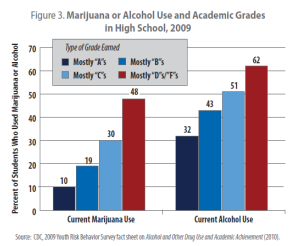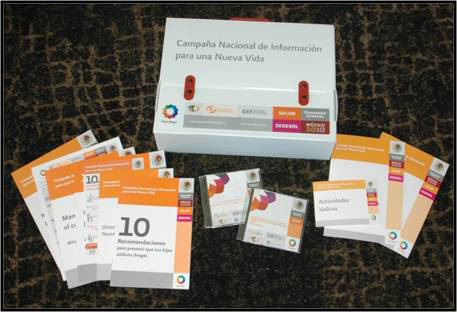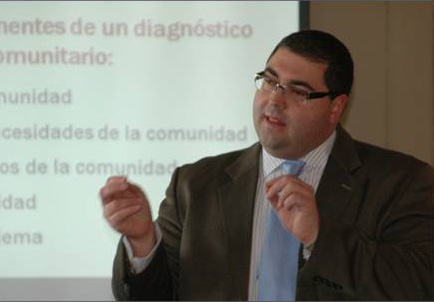Chapter 1. Strengthen Efforts to Prevent Drug Use in Our Communities
Chapter Table of Contents
Introduction
Drug and alcohol use affects health outcomes, job opportunities, family life, military preparedness, and academic outcomes. Findings from several national surveys show that teen marijuana use may be increasing and that the perceived risk of marijuana use is decreasing. Historically, research demonstrates that drug use among youth increases when the perceived danger of using drugs decreases.
Therefore, now more than ever, it is critical to focus resources and efforts on preventing use before it ever starts. This is not only common sense, but is cost-effective: For every dollar invested in prevention, up to 10 dollars in treatment for alcohol or other drugs can be saved.
The consequences of substance use on academic performance are significant and demonstrate why we must invest in prevention efforts. For example, the CDC found that 9th to 12th graders who received grades of mostly Ds and Fs were twice as likely to be current alcohol users, five times more likely to be current marijuana users, and 13 times more likely to be current cocaine users, compared to students receiving A grades. In a study of first-year college students who used marijuana five or more times in the past year, nearly 25 percent were found to meet the diagnostic criteria of abuse or dependence. Of these students, 24 percent regularly put themselves in physical danger when under the influence, 40 percent reported concentration problems, and 14 percent reported missing class due to their drug use. Marijuana or Alcohol Use and Academic Grades in High School, 2009 Bar chart shows Marijuana or Alcohol Use and Academic Grades in High School, 2009 Source: CDC, 2009 Youth Risk Behavior Survey fact sheet on Alcohol and Other Drug Use and Academic Achievement (2010).

Risk factors specific to substance use (e.g., truancy, deviant peers, school failure) must be considered when designing prevention programs. Effective drug prevention is comprehensive and includes a combination of evidence-based interventions and environmental strategies and policies to enforce the consequences for substance-related offenses; reduce the access to substances; and decrease the likelihood of use.
A basic tenet of the Strategy is that the Nation’s drug problems require not only Federal attention but also local partnerships to develop effective solutions. Prevention efforts are most successful when they involve multiple sectors of a community, such as schools, health and social service systems, law enforcement, faith communities, local businesses, and neighborhood organizations.
The National Prevention Council
As part of the Affordable Care Act, on June 10, 2010 the President signed an Executive Order creating the National Prevention, Health Promotion, and Public Health Council (the National Prevention Council). Chaired by the Surgeon General, the Council consists of senior officials from 17 Federal departments and is charged with providing coordination and leadership among all executive departments and agencies with respect to prevention, wellness, and health promotion practices. To do so, the National Prevention Council is developing a National Prevention and Health Promotion Strategy with input from the public and other interested stakeholders. Planned for release in spring 2011, this Strategy provides the foundation for our Nation’s prevention efforts and will address seven priority areas aimed at addressing the leading causes of death, including drug abuse and excessive alcohol use. Goals and performance measures for the National Prevention Strategy’s section on drug abuse and excessive alcohol use were informed by those established in the National Drug Control Strategy, thus ensuring compatibility with the Administration’s existing plan to reduce drug use and its consequences. Further information about the National Prevention Council can be found at http://www.healthcare.gov/center/councils/nphpphc/index.html
Principle 1. A National Prevention System Must be Grounded at the Community Level
The Drug Free Communities Support Program
ONDCP’s Drug Free Communities (DFC) Support Program is a critical component of the Nation’s drug prevention infrastructure. It is built on the premise that Federal and state assistance for prevention is most effective when supporting programs that originate in, and are developed by, communities. To this end, the DFC program provides resources to community-based coalitions to develop data-driven strategic plans that increase community collaboration that reduce youth substance use. In August 2010, ONDCP, in collaboration with the Substance Abuse and Mental Health Services Administration (SAMHSA), awarded DFC grants totaling $85.6 million to 741 communities.
DFC coalitions connect with the community at a “grassroots” level to help identify and respond to their unique local drug problems by using environmental strategies aimed at addressing community factors that may contribute to youth substance use. These strategies may include addressing school policies related to possession of drugs on campus and limiting the number of alcohol retailers near parks, schools, or other places that youth congregate. By working together, coalitions can create changes that reduce the social and health consequences of drug use by limiting access to illegal substances and by changing social and cultural norms that promote such risky behaviors. The DFC approach is effective and sustainable long after grant funds are provided—an outcome not achieved by programs that do not seek to create environmental change.
To increase the program’s outreach to special populations, the Program hosted two American Indian/ Alaska Native (AI/AN) technical assistance sessions at Fiscal Year (FY) 2011 Applicant Workshops in San Diego and Washington, D.C. The workshops were designed to provide technical assistance specific to the challenges faced by applicants serving AI/AN populations. As of the FY 2010 funding, 10 percent of all DFC-funded coalitions serve tribal communities. (Action Item 1.2A)
The DFC program undergoes a national cross-site evaluation each year that uses data provided by its grantees. These data indicate that since January 2002, past 30-day use of alcohol, tobacco, and marijuana declined significantly in both middle school and high school-aged youth in areas served by DFC coalitions. Moreover, prevalence of 30-day use across all substances was lower for DFC high school students than among a nationally representative sample of high school students taking the Youth Risk Behavior Survey (YRBS). The differences between DFC and YRBS were statistically significant for alcohol in 2003, 2005, 2007, and 2009. Differences in prevalence of 30-day use were also statistically significant for marijuana in 2003, 2005, and 2007.
Reaching Out to Military Personnel and their Families
Studies show that individuals with post-traumatic stress disorders, such as returning active duty personnel and Veterans, are more susceptible to substance use. The Administration recognizes the profound importance of ensuring the health and well-being of servicemen and women and their families. To help address these issues, DOD has developed and will work with other agencies to further improve prevention, resilience and community assistance programs. In 2011, ONDCP will use the DFC coalition model to help build the prevention capacity of communities with military families.
Promoting Successful, Safe, and Healthy Students
The Administration’s reauthorization plan for the Elementary and Secondary Education Act recognizes that the children and young people most at risk for drug abuse and academic failure too often attend schools and live in communities that fall short in meeting their basic needs.
To address these resource-poor schools and communities, the Successful, Safe, and Healthy Students (SSHS) program will build on competitions under the Safe and Drug-Free Schools and Communities National Programs. SSHS will provide $365 million in funding to increase the capacity of state educational agencies (SEAs), high-need local educational agencies (LEAs), and their partners to develop and implement programs and activities, including those focused on preventing drug use, alcohol use, bullying, harassment, or violence and promoting the physical and mental well-being of students.
Strategic Prevention Framework
SAMHSA’s Strategic Prevention Framework-State Incentive Grant (SPF-SIG) program has also contributed to building a national prevention infrastructure. The SPF-SIG program helps states and communities implement effective prevention programs using a data-driven, strategic planning process. This program requires most funding be directed to community-level organizations such as coalitions. In 2010, SAMHSA awarded 10 new SPF-SIG grants totaling $10.6 million, bringing the current total number of SPF-SIG awardees to 49 states, 8 jurisdictions, 19 tribes, and the District of Columbia. In total, the program has reached more than 800 communities.
In the President’s FY 2012 Budget, the elements of this successful program are being required within a State Prevention Grant program as well as a Behavioral Health Tribal Prevent Grant program to help support all states and tribes implement a data-driven local approach to preventing substance abuse.
Findings from an evaluation of the first cohort of SPF grantees (2006) show positive changes in a number of outcomes over the course of 12 months: 42 percent of grantees showed improvements in perception of risks of drug use by both youth and adults; 68 percent of grantees had improvement of disapproval rates of peer substance use by 12- to 17- year-olds; 74 percent of grantees showed improvement of past 30-day drinking rates by youth ages 12 to 20 years; and 68 percent of grantees improved in past 30-day drug use rates among both youth and adults.34 The majority of interventions were evidence-based, and nearly half were environmental strategies.
The President’s FY 2012 Budget reflects plans to establish a new Substance Abuse State Prevention Grant (SASPG), which will bring the SPF-SIG approach to scale across the Nation. Specifically, the SASPG will provide enhanced prevention funding to ensure every state and territory makes prevention of substance abuse a priority and does so using data-driven strategic planning.
The National Youth Anti-Drug Media Campaign
The National Youth Anti-Drug Media Campaign (Media Campaign) is frequently the only media message to counter the barrage of pro-drug messaging to which young people are exposed. There is a common misperception among many parents and youth that prescription drugs are less dangerous when abused than illegal drugs because they are approved by the Food and Drug Administration (FDA). This misperception, coupled with increased direct-to-consumer advertising, which has been linked to overutilization and is the most rapidly increasing form of pharmaceutical marketing, makes effective educational programs even more vital to combating prescription drug abuse.
In June 2010, the Media Campaign launched a redesigned “Above the Influence” (ATI) Campaign with a broadened focus on those substances most often abused by teens. (Action Item 1.2B) ATI has become one of the most widely recognized youth brands in the country, and 80 percent of teens are aware of ATI advertising.
In addition to new national-level prevention messaging, the Media Campaign works directly with communities to amplify the effects of the national ATI Campaign and to encourage youth participation in the ATI initiative through the help of on-the-ground partner organizations, such as DFC coalitions, Boys & Girls Clubs, Students Against Destructive Decisions (SADD), Y’s (formerly YMCAs), Girls, Inc., and ASPIRA, a national nonprofit organization devoted solely to the education and leadership development of Puerto Rican and other Latino youth.
This new multi-tiered approach allows the Media Campaign to reach teens across the country with a highly visible national advertising presence while providing resources that can be localized to meet the needs of individuals and local youth-serving organizations. In this way, ATI is helping provide a voice to the majority of teens who choose to be above the influence of drug and alcohol use.
Evidence for the effectiveness of the ATI Campaign recently appeared in a study published by the peerreviewed journal Prevention Science. This independent scientific analysis, funded through a grant by the National Institute on Drug Abuse (NIDA), concluded that “exposure to the ONDCP [ATI] campaign predicted reduced marijuana use.” The analysis showed that those youth who reported exposure to the ATI Campaign were less likely to begin use of marijuana compared to those not exposed to the ATI Campaign—a finding consistent with the Media Campaign’s own year-round Youth Ad Tracking Survey results.
The Media Campaign also runs an Anti-Meth Campaign each year to prevent and reduce methamphetamine use in areas of the country most severely affected by methamphetamine, as well as among specific populations with higher incidence of use, including American Indians and Alaska Natives.
“Above the Influence:” Engaging Local Communities
The National Youth Anti-Drug Media Campaign relaunched its ATI youth brand, with broad prevention messaging at the national level—including television, print, and Internet advertising—as well as more targeted efforts at the local level. Since the relaunch, results from the Media Campaign’s year-round tracking study of teens between the ages of 14 and 16 show a significant increase in teens’ awareness of ATI messages. More important, teens who either were exposed to, or interacted with, ATI had significantly stronger anti-drug beliefs than teens who were not exposed or did not interact with it. To foster youth participation at the community level, the Media Campaign has partnered with more than 40 youth-serving organizations in more than 20 communities37 across the country and provided technical assistance and training to more than 500 community organizations through conference workshops and webinars, with the objectives of:
- Actively engaging youth at the local level to allow them to inform and inspire the campaign;
- Providing local youth-serving organizations with a recognized, national platform to further their specific
- Goals and initiatives; and
- Providing localized advertising across the more than 20 communities—including posters and bus shelter
- Ads featuring artwork created by teens and customized banners in 1,150 high schools—to generate
- Additional awareness.
Campaign partners include DFC grantees, the Boys & Girls Club of America, the Y, Girl’s Inc., ASPIRA, and SADD.


Prevention Prepared Communities
Effective prevention requires the collaboration of multiple service systems in a community. Education, child welfare, juvenile justice, health care, and behavioral health care are just a few of the systems required to ensure a comprehensive prevention infrastructure. Unfortunately, resources from these systems are often scattered and difficult to coordinate, resulting in a patchwork of services that do not meet a community’s needs.
In 2010, a Federal interagency team developed a proposal for a competitive grant program called Prevention Prepared Communities (PPC) to provide Federal support to locally based prevention systems. Proposed in the President’s FY 2011 and FY 2012 Budgets, this $22.6 million project is designed to lay the foundation for a national, evidence-based, community-oriented prevention system. A collaborative effort of the Department of Health and Human Services (HHS), the Department of Education (Education), the Department of Justice (DOJ), and ONDCP, PPC will provide local communities and states with resources to implement a comprehensive array of programs to reduce the multiple risk factors associated with the onset and progression of substance use and associated mental, emotional, and behavioral problems among youth. (Action Item 1.1B)
Strengthening Communities along the Southwest Border
To address the fragmentation of prevention programs along the Southwest border, the 2011 National Southwest Border Counternarcotics Strategy will dedicate a section to coalition building, research on culturally appropriate interventions, and workforce development. Currently there are 17 DFC coalitions within 100 miles of the Southwest border. The actions planned by these coalitions include expanding the reach of the DFC Support Program to border communities and continued operation of Forces United, an innovative program supported by the California Border Alliance Group, part of the network of 28 ONDCP-funded High Intensity Drug Trafficking Areas (HIDTAs). Forces United brings military organizations (such as the National Guard) together with existing community-based organizations and programs to work collectively on local drug prevention efforts. Specifically, this involves using military personnel as positive role models to help disseminate information about drug use and its negative consequences. These personnel conduct educational forums, participate in various prevention initiatives in schools and other community settings, and deliver Parent Connection, a program developed and conducted by the California National Guard that is designed to improve parenting skills.
In addition, HHS will continue to support U.S. counties along the border with Mexico by providing customized, culturally appropriate training and technical assistance for state and local prevention providers and practitioners.
To further support border communities, the DOJ will implement Latino360, a Spanish language drug prevention program designed to mobilize community members against the threat of methamphetamine.
Community Coalition Support along the Southwest Border
The consumption, smuggling, and distribution of illicit drugs along the U.S.-Mexico border erodes societies, endangers families, and provides illicit earnings that fuel corruption, crime, and violence. Illicit drugs and the drug culture lure children away from school and adults away from legitimate work. On February 25, 2010, the Declaration of Drug Demand Reduction Cooperation was signed at the 8th U.S.-Mexico Bi-National Drug Demand Reduction Policy Meeting held in Washington, D.C. The Declaration underscored the concept of mutual responsibility and acknowledged the duty to take action domestically, bilaterally, and regionally to reduce drug use.
In December 2010, ONDCP sponsored two bi-national cross-border coalition-building workshops in partnership with HHS, the Community Anti-Drug Coalitions of America (CADCA), the Army National Guard, the Southwest Border HIDTAs, the Department of State, and the Government of Mexico. Workshops were held in San Diego, CA, and El Paso, TX, and attended by representatives from both sides of the border. They were designed to assist communities in building anti-drug coalitions as catalysts for evidence-based approaches to community problem solving. Training materials used in the workshops included a prevention toolkit developed and provided by the Government of Mexico. (Action Item 1.4C)


Principle 2. Prevention Efforts Must Encompass the Range of Settings in Which Young People Grow Up
Multiple factors influence the likelihood a young person will use drugs. Moreover, some factors may be more powerful than others at certain stages of life. For example, although peer pressure during the teenage years can influence attitudes toward drug use, a strong parent-child bond early in life can help reduce this. For this reason, effective community-based prevention requires coverage of a broad range of settings in which young people grow up, including families, schools, clubs, worksites, recreational programs, and faith-based centers. In addition to the numerous examples of programs and campaigns described above that focus on youth and teens, it is also important to focus on college students, who are also susceptible to the pressures to use substances.
Addressing Substance Use among College Students
About 40 percent of college students report binge drinking.38 Other drug use, including marijuana and prescription drug abuse, is also of concern. About 25 percent of college students report academic consequences of their drinking, including missing class, falling behind, doing poorly on exams or papers, and receiving lower grades. In addition, college administrators report believing that alcohol specifically was involved in 21 percent of all cases of student attrition.
Reducing substance use behaviors among college students requires prevention strategies at the college or university as well as in the surrounding off-campus community. In response, Education launched an initiative in 2010 to provide a more integrated and comprehensive response to issues related to alcohol and other drug use on college campuses as well as violence among college students. This includes a new Healthy College Campuses grant program called for in the Administration’s FY 2011 and 2012 budgets. It also includes ongoing technical assistance provided via the Higher Education Center for Alcohol, Drug Abuse, and Violence Prevention. (Action Item 1.3A) In addition, Education, HHS, and ONDCP are collaborating to identify and partner with university leaders to more effectively address the high rates of substance use and its consequences among college students.
Ensuring a Drug Free Workplace
The consequences of the illicit use of drugs are also seen in America’s workforce. Drug use has a serious impact upon job related accidents and injuries, absenteeism, health care costs, and productivity losses. Workers who use illicit drugs are more likely to injure themselves or others in a workplace accident and have higher rates of absenteeism. They also incur higher medical costs than employees who do not use illicit drugs.
Workplace programs that provide clear policies about drug use, offer prevention and education opportunities for employees and supervisors, conduct drug testing, and support referral and treatment for those with substance use disorders can play a large role in reducing the demand for drugs throughout our Nation and in helping drug users get into treatment. In addition to deterring illicit drug use, these programs provide employees with the opportunity to self-identify. Often, the programs enable employees to return to the same job, or a similar job in the same industry, thereby creating an incentive to succeed in their recovery to resume a fulfilling career. Ultimately, drug-free workplace programs are good for our labor force, families, and communities.
Principle 3. Develop and Disseminate Information on Youth Drug, Use
Communicating the Health Risks of Youth Drug Use
An important ingredient for preventing drug use is ensuring that communities, youth, parents, and healthcare providers have the most up-to-date scientific information about drug use and its consequences. The Office of the Surgeon General, in collaboration with several HHS agencies and ONDCP, is developing a series of reports on the health risks of youth drug use. The first in this series, focusing on prescription drug abuse, will be released in 2011. The report will build upon NIH-supported research. (Action Item 1.3B)
